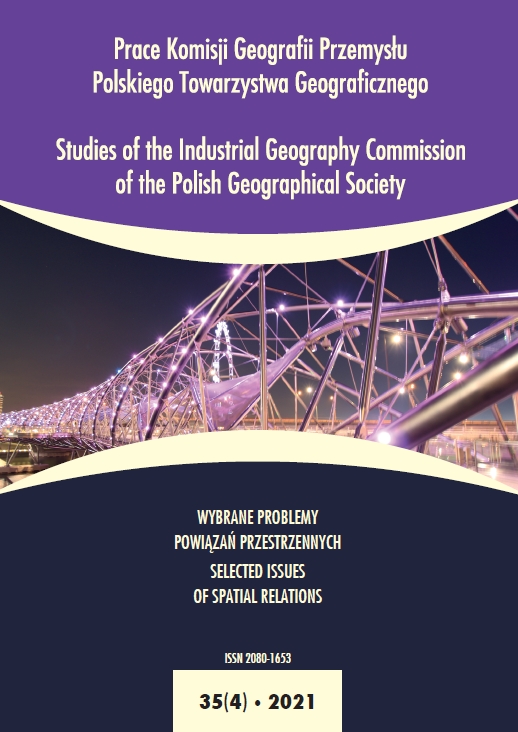Spatial and functional transformations of post-port areas in Szczecin (Poland) in the context of classical city-port models
DOI:
https://doi.org/10.24917/20801653.354.7Keywords:
port cities, port, urban planning, brownfields, waterfrontsAbstract
The purpose of this paper is to confront the theoretical issues present in the academic literature in the form of spatial-functional models for urban and port areas with the observed relationships for these areas based on the example of a selected city in Poland. The article addresses the issues of universality of models created by geographers and urban planners studying the evolution of city/port systems in the context of changing global trends in technology, economics and scale of maritime transport. The article describes the interface zone, the area where the city and the port meet, which in the current economic conditions and aspirations of contemporary cities to revitalise their space is turning into a zone with great potential. Examples of such opportunities include Rotterdam, Hamburg, Copenhagen, Baltimore, Gdańsk and, similar in size to Szczecin, the city of Bilbao. The success of these cities shows that the effort of revitalisation brings them great branding benefits. The article contains a description of the development of relations between the city of Szczecin and its “genetic code” of port and industrial areas, together with an outline of the city’s future intentions and plans for the inherited port areas.
Downloads
Metrics
References
Architektura Murator. (2017). Szczecińska Łasztownia – wyniki konkursu. Pozyskano z https://architektura.muratorplus.pl/projekty/szczecinska-lasztownia-wyniki-konkursu_8019.html (15.08.2021).
Bird, J. (1963). The Major Seaports of the United Kingdom. London: Hutchinson.
Borruey, R. (1992). Réinventer une ville-port? Le cas de Marseille. Cahiers de la Recherche Architecturale, 30/31, 127−146.
Borruey, R., Fabre, M. (1992). Marseille et les nouvelles échelles de la ville portuaire. Annales de la Recherche Urbaine, 55/56, 53−62.
Brocard, M. (1994). Deux villes frontières portuaires. Le Havre et Southampton. La Revue d’Ici, 11, 8−12.
Cowan, D., Bunce, S. (2006). Competitive Cities and Secure Nations, Conflict and Convergence in Urban Waterfront. International Journal of Urban and Regional Research, 30(2), 427−439.
Ducruet, C. (2005). Approche comparée du développement des villes-ports à l’échelle mondiale. Problèmes théoriques et méthodologiques. Cahiers Scientifiques du Transport, 48, 59−79.
Ducruet, C. (2011). The port city in multidisciplinary analysis. W: J. Alemany, R. Bruttomesso (red.), La ciudad portuaria del siglo XXI. Nuevos desafíos en la relacíon puerto-ciudad = The port city in the XXI century. New challenges in the relationship between port and city. Venezia: RETE, 32−48.
Forno, G. (1985). Gênes. Ville-port. Renaissance Urbaine en Europe. Etude, 27, 75–84.
Flis, J. (1985). Szkolny słownik geograficzny. Warszawa: WSiP.
Gołębiewski, J.I. (2016). Perspektywy rewitalizacji Międzyodrza w Szczecinie. Praca doktorska. Zachodniopomorski Uniwersytet Technologiczny w Szczecinie.
Gostomski, E., Nowosielski, T. (2021). Ewolucja i znaczenie portów morskich w krajach Unii Europejskiej. Gdańsk: Wydawnictwo Uniwersytetu Gdańskiego.
Hayuth, Y. (1982). The port-urban interface. An area in transition. Arel, 4(3), 219–224.
Hoyle, B.S. (1988). Development dynamics at the port-city interface. W: B.S. Hoyle i in. (red.), Revitalising the Waterfront. International Dimensions of Dockland Redevelopment. London: Belhaven, 3–19.
Hoyle B.S. (1998). Cities and ports. Concepts and issues. Journal of Vegueta, 3, 263−278.
Kotla, R. (2007). Z dziejów szczecińskiego portu. Magazyn Portowy ZMPSiŚ SA, 1.
Marcadon, J. (1997). La stratégie des armements maritimes et les métropoles portuaires. W: P. Claval, A.L., Sanguin (red.), Métropolisation et Politique. Paris: L’Harmattan, 189−203 (Collection ‘Géographie et Culture).
Norcliffe, G., Basset, K., Hoare, T. (1996). The emergence of postmodernism on the urban waterfront. Journal of Transport Geography, 4(2), 123–134.
Notteboom, T. (1997). Concentration and load centre development in the European container port system. Journal of Transport Geography, 5(2), 99−115.
O’Connor, K. (1989). Australian ports, metropolitan areas and trade-related services. Australian Geographer, 20(2), 167−172.
Palmowski, T., Bocheński, T. (2015). Polskie porty morskie i rola kolei w ich obsłudze na przełomie XX i XXI wieku. Gdańsk; Pelplin: Wydawnictwo „Bernardinum”, 46–49 (Regiony nadmorskie; 23).
Palmowski, T., Pacuk, M., Michalski, T. (2001). Przemiany przestrzeni miejskiej miast portowych na przykładach Gdańska i Gdyni. W: Miasto postsocjalistyczne. Organizacja przestrzeni miejskiej i jej przemiany. XIV Konwersatorium wiedzy o mieście. Łódź: Łódzkie Towarzystwo Naukowe.
Rada Miasta Szczecin. (2010). Lokalny Program Rewitalizacji dla Miasta Szczecin. Pozyskano z http://konsultuj.szczecin.pl/konsultacje/files/9CD543BAF70F4D37A35893B6EE94C6DD/002%20na%20BIP.pdf
Runge, S. (2018). Przeobrażenia funkcjonalno-przestrzenne miast tradycyjnego regionu społeczno-ekonomicznego – wymiar teoretyczny. Studia Miejskie, 32, 21–33.
Seassaro, L. (1992). Gênes, ou le poids de la longue durée culturelle. Annales de la Recherche Urbaine, 55/56, 10−21.
Studium Uwarunkowań i Kierunków Zagospodarowania Przestrzennego Szczecina. (2012). Uchwała Nr XVII/470/12 Rady Miasta Szczecin z dnia 26 marca 2012 r. Pozyskano z http://bip.um.szczecin.pl/chapter_11398.asp (dostęp 5.11.2021).
Uchwała Nr XII/268/11 Rady Miasta Szczecin z dnia 24 października 2011 r. Dziennik Urzędowy Województwa Zachodniopomorskiego Nr 134 poz. 2418.
Vigarié, A. (1979). Ports de commerce et vie littorale. Paris: Hachette.
Zaremba, P. (1962). Urbanistyka miast portowych. Szczecin: Szczecińskie Towarzystwo Naukowe.
Zarząd Morskich Portów Szczecin i Świnoujście S.A. (2021, 4 kwietnia). Historia Portów. Pozyskano z https://www.port.szczecin.pl/pl/porty/historia/#
Żyszkowska, W., Spallek, W., Borowicz, D. (2012). Kartografia tematyczna. Warszawa: PWN.
Downloads
Published
How to Cite
Issue
Section
License
Copyright (c) 2021 Studies of the Industrial Geography Commission of the Polish Geographical Society

This work is licensed under a Creative Commons Attribution-NoDerivatives 4.0 International License.
Articles are published under the terms of the Creative Commons License (CC BY-ND 4.0; Attribution– NoDerivs).

